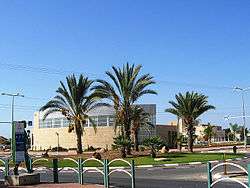Ofakim
Ofakim
| ||
|---|---|---|
| Hebrew transcription(s) | ||
| • ISO 259 | ʔopaqim | |
 | ||
| ||
 Ofakim | ||
| Coordinates: 31°19′N 34°37′E / 31.317°N 34.617°ECoordinates: 31°19′N 34°37′E / 31.317°N 34.617°E | ||
| District | Southern | |
| Founded | 19 April 1955 | |
| Government | ||
| • Type | City | |
| • Mayor | Yitzhak Danino | |
| Area | ||
| • Total | 10,273 dunams (10.273 km2 or 3.966 sq mi) | |
| Population (2015)[1] | ||
| • Total | 25,638 | |
| Name meaning | Horizons | |
Ofakim (Hebrew: אֳפָקִים), (lit. "horizons") is a city in the Southern District of Israel, 20 kilometers west of Beersheba. It was founded as a development town on 19 April 1955. In 2015 it had a population of 25,638. The mayor is Zvika Greengold.[2]
History

Ofakim was established in 1955 as a regional center for the rural communities in the area. The early residents were Jewish immigrants from North Africa and India.[2]
Demographics

In 2001, the ethnic makeup of the city was 99.7% Jewish and other non-Arab, with no significant Arab population. There were 11,200 males and 11,800 females – 41.8% 19 years of age or younger, 14.5% between 20 and 29, 18.5% between 30 and 44, 12.5% from 45 to 59, 3.6% from 60 to 64, and 9.1% 65 years of age or older. The population growth rate in 2001 was 0.6%.
About 30 percent of the residents are ultra-Orthodox, many of them newly observant. Another 30 percent are immigrants, mostly from the former Soviet Union. The rest are descendants of the founding generation, immigrants from North Africa and India who arrived in the town in the 1950s and 1960s. Ofakim also has a small community of Ethiopian Jews.[2]
Economy
As in other development towns, the industrial sector has historically played an important part in Ofakim's economy. In 1972, 32% of the salaried workers (754 people) were in this sector, and in 1983—924 people (23%). During this period, the textile industries consistently employed by far the most workers, ranging from 72% (1982–83) to 82% (1972). The Of–Ar (short for Ofakim–Argentina) textile factory was a major employer.[3]
Education
In 2001, there were 19 schools and 4,704 students in the city – 13 elementary schools (3,079 students), and 8 high schools (1,625 students). 43.3% of 12th grade students were entitled to a matriculation certificate.
Sports
One of Israel's 14 tennis centers is located in Ofakim.[4] It opened in 1990 and has six courts. The city also has a soccer stadium.
Development plans
A train station opened in 2015 with a car park for 1,000 cars, and an old industrial building is being converted into an art museum.[2] The Nahal Shomriya cycling route around Ofakim was inaugurated in 2010. The 60-centimeter-wide single route winds through 1,500 dunams (approx 375 acres) in Ofakim Forest, passing through Nahal Shomriya and Nahal Patish, and looping around eight local moshavim.[5]
Notable residents
- Oren Smadja, judoka
- Robert Tiviaev, former Knesset member
References
| Wikimedia Commons has media related to Ofakim. |
- ↑ "List of localities, in Alphabetical order" (PDF). Israel Central Bureau of Statistics. Retrieved 16 October 2016.
- 1 2 3 4 New Horizons for Ofakim
- ↑ Schwarz, Dafna (2009). "Industrialization Attempts in Three Development Towns: Ofakim, Migdal HaEmek and Ma'alot". In Halamish, Aviva; Meir-Glitzenstein, Esther; Tzameret, Zvi. The Development Towns. Idan Series Vol. 24 (in Hebrew). Yad Yitzhak Ben Zvi. pp. 160–162. ISBN 978-965-217-298-3.
- ↑ Tennis doubles coexistence program
- ↑ Riding and Building New Ofakim – Shomriya Cycling Route
